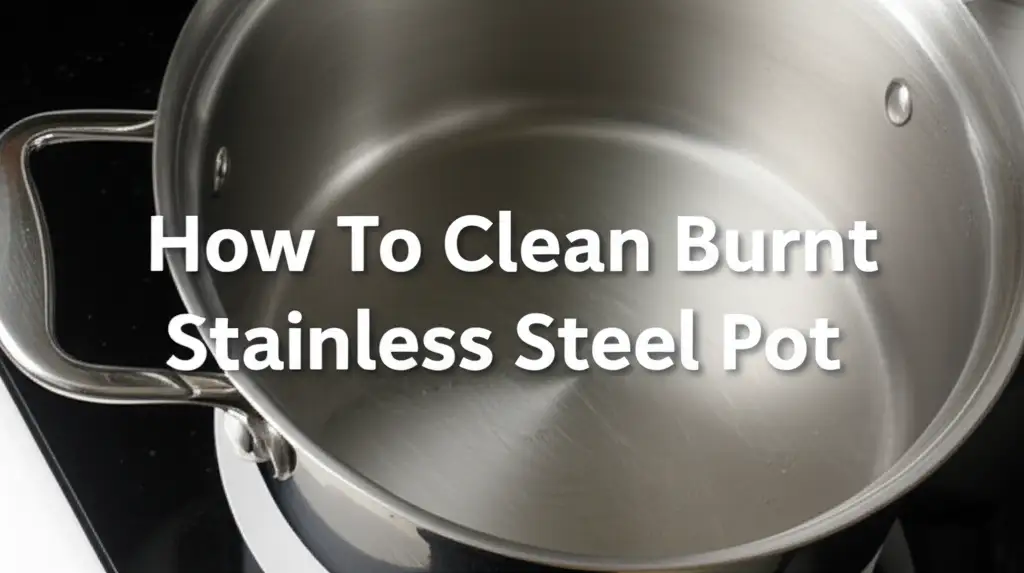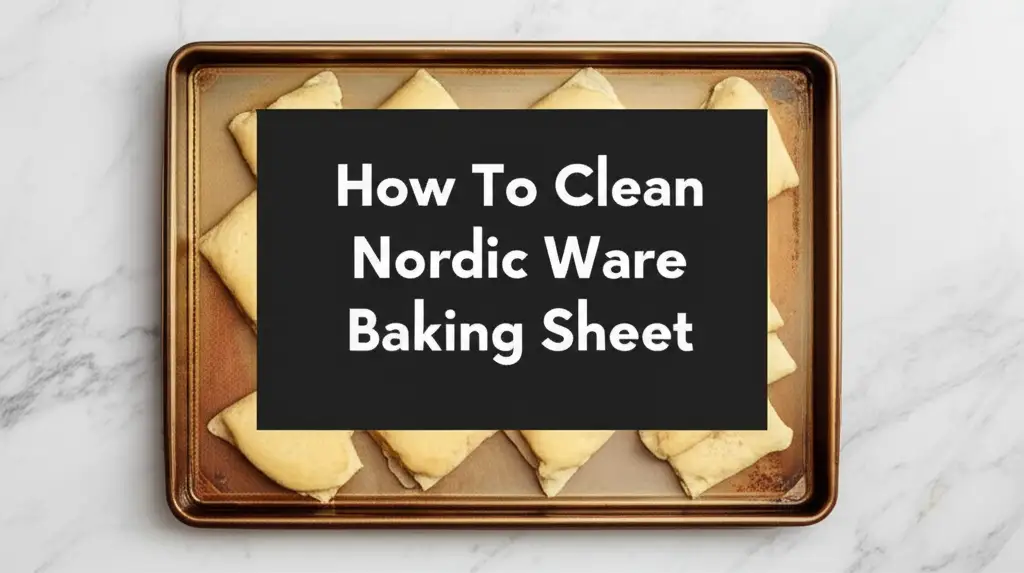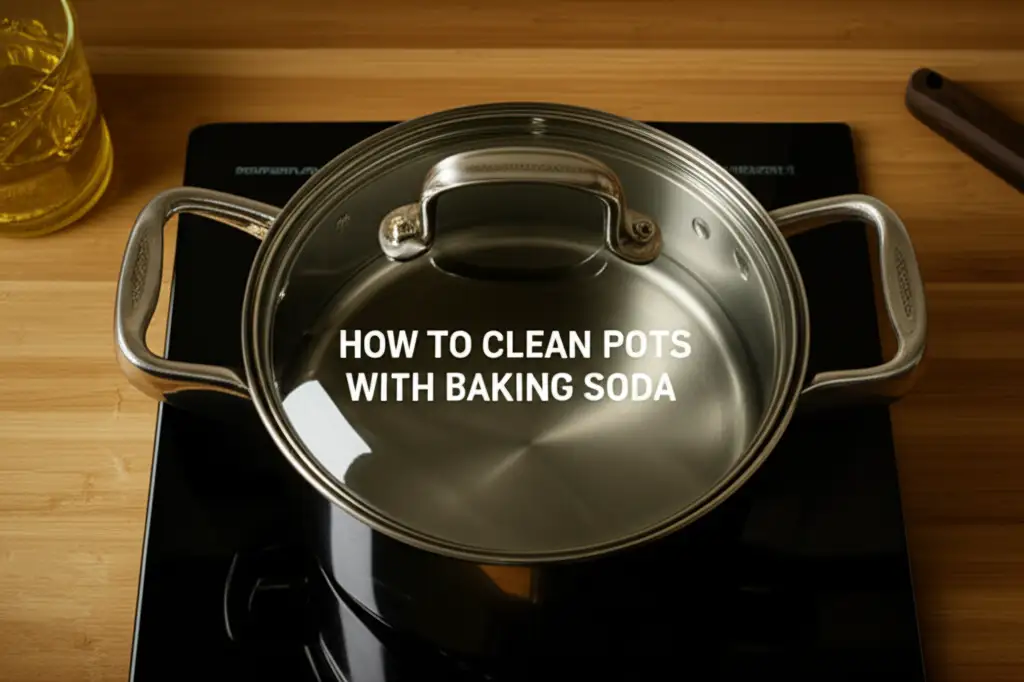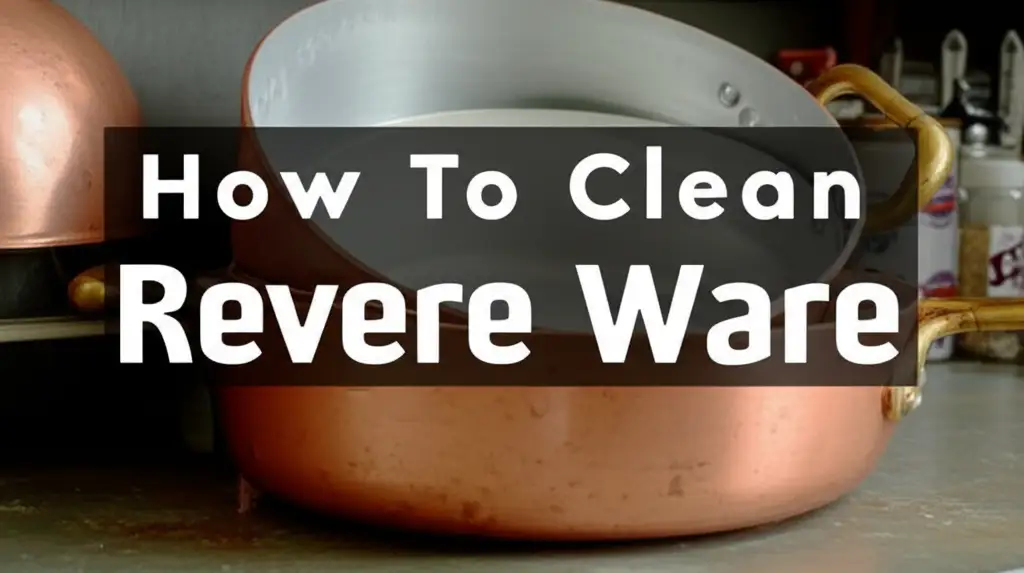· Kitchen Cleaning · 14 min read
How To Clean Burnt Stainless Steel Pot

Restore Your Cookware: How to Clean Burnt Stainless Steel Pots Effectively
“Oh no, not again!” We have all been there. A moment of distraction turns your shiny stainless steel pot into a blackened mess. Burnt food sticks hard, creating a challenging cleaning task. But do not worry; a burnt stainless steel pot does not mean the end of your favorite cookware. I can help you bring that pot back to life. This guide shares proven methods to clean burnt stainless steel pots, from simple soaks to powerful pastes. You will learn practical steps to restore your pots to their former glory.
Takeaway
- Soak the pot immediately after use to loosen residue.
- Use baking soda and vinegar for effective, non-abrasive cleaning.
- Gentle scrubbing with appropriate tools prevents scratches.
- Choose methods based on the severity of the burn.
- Always rinse thoroughly after cleaning to remove all residues.
Main Query Answer
You can clean a burnt stainless steel pot by first soaking it with hot water and dish soap. Then, use a paste of baking soda and a little water, or a mixture of baking soda and vinegar, to scrub away the burnt residue. For tougher stains, consider boiling water with baking soda or even using oven cleaner.
Why Your Stainless Steel Pot Burns: Understanding the Challenge
A burnt stainless steel pot is a common kitchen issue. It happens when food overheats and sticks to the bottom. The heat creates a carbonized layer. This layer is very stubborn. It bonds tightly with the metal surface. Standard dish soap and a sponge often fail against it. This carbon layer requires a stronger approach.
Stainless steel is durable, but not completely stain-proof. High heat causes food particles to break down. They change into a hard, dark crust. This crust resists simple washing. Sometimes, oil and grease can also burn onto the surface. This creates another difficult residue. Understanding what makes the burn so tough helps you choose the right cleaning method.
When you cook, a small amount of oil or food can bond with the pot’s surface. If this material gets too hot, it scorches. This creates a challenging stain to remove. The longer the burn sits, the harder it becomes. Removing this black layer needs patience and the right tools.
This article gives you the steps. We will explore ways to remove these tough stains. You can bring your stainless steel pot back to life. No matter how bad the burn looks.
First Steps: Gentle Soaking to Tackle Light Burns
When you burn a stainless steel pot, do not despair. The very first step is often the easiest. It involves a simple soak. This method works well for lighter burns. It also helps loosen more severe scorched areas. Start this process as soon as the pot cools down.
Fill the pot with hot water. Add a few drops of dish soap. Let it sit for several hours. Overnight is often best. The hot water and soap begin to break down the burnt food. This softens the hardened residue. It makes it easier to remove later.
After soaking, try to gently scrape the burnt bits. Use a wooden spoon or a plastic spatula. Avoid metal utensils. They can scratch your pot. You might be surprised how much comes off easily. This initial soak saves you effort. It prepares the pot for deeper cleaning.
For some light burns, this soak might be enough. You might find most of the residue lifts away. Then, a quick scrub with a non-abrasive sponge finishes the job. This method is safe for your pot. It prevents damage that harsh scrubbing can cause.
Remember, patience is key here. Do not rush the soaking process. Give the water and soap time to work their magic. This first gentle step is crucial. It often dictates the success of further cleaning attempts.
The Power of Baking Soda: A Natural Way to Clean Burnt Stainless Steel
Baking soda is a kitchen miracle worker. It helps immensely when you need to clean burnt stainless steel pots. This gentle abrasive is effective. It does not scratch the pot’s surface. Baking soda works by breaking down acidic burnt residues. It also helps lift stubborn food particles. I find it to be my go-to for most burn marks.
Making a Baking Soda Paste
This method is simple and highly effective. First, remove any loose burnt bits from the pot. Do this after an initial soak if possible. Next, sprinkle a generous layer of baking soda over the burnt area. Add just enough water to create a thick paste. The paste should cover all the black marks.
Let this paste sit. Give it at least 15-30 minutes. For severe burns, let it sit for a few hours. Some people leave it overnight. The baking soda works to absorb odors and lift the burnt material. After soaking, use a non-abrasive scrub pad. Gently scrub the burnt areas. You will see the residue start to come off. Rinse well. You might need to repeat this step for very tough spots.
The Boiling Baking Soda Method
For more stubborn burnt-on food, boiling baking soda is effective. Fill the pot with water. Add about 1/2 cup of baking soda. Place the pot on the stove. Bring the water to a boil. Let it simmer for 10-15 minutes. The boiling action, combined with baking soda, loosens the residue.
Carefully pour out the water. Be cautious as it will be hot. Let the pot cool slightly. While still warm, scrape the softened burnt bits. A wooden spoon works well. Then, use a non-abrasive sponge or brush. Scrub away any remaining residue. This method is particularly useful for widespread burns. It helps you clean your stainless steel pans with baking soda effectively.
Vinegar’s Role: Partnering with Baking Soda for Tough Stains
Vinegar is another powerful cleaner. It contains acetic acid. This acid helps dissolve burnt-on food. When combined with baking soda, it creates a fizzing reaction. This reaction helps lift stubborn grime. I often turn to this duo for the toughest burn marks. It is a fantastic combination for restoring your burnt stainless steel pot.
Vinegar and Baking Soda Boil
This method is similar to the boiling baking soda method, but adds vinegar. First, pour a layer of white vinegar into the bottom of the pot. Ensure it covers the burnt area. Bring the vinegar to a boil on the stove. Let it simmer for a few minutes. Then, turn off the heat.
Carefully sprinkle baking soda into the hot vinegar. It will fizz vigorously. This reaction helps dislodge burnt residue. Let the mixture sit for 15-30 minutes. The longer it sits, the more effective it is. After cooling, pour out the liquid. Scrape the remaining burnt bits with a wooden or plastic utensil. Finish by scrubbing with a non-abrasive pad. This method is excellent for breaking down even the most stubborn residues. It allows you to clean with vinegar and baking soda efficiently.
Simple Vinegar Soak
Sometimes, a simple vinegar soak is all you need. This works well for burnt-on oil or general discoloration. Pour enough white vinegar into the pot to cover the burnt spots. Let it sit for several hours. Overnight is ideal. The vinegar’s acidity slowly breaks down the burnt material.
After soaking, scrub the pot with a non-abrasive sponge. The residue should come off more easily. This method is less aggressive than boiling. It is good for general maintenance. It also helps remove any lingering odors. Vinegar is a versatile cleaner for your kitchen. You can use it to clean stainless steel appliances with vinegar too, showing its cleaning power.
Lemon and Salt: An Acidic Solution for Pot Restoration
Lemon and salt offer an alternative natural method. This combination uses the acidity of lemon. It also uses the abrasive power of salt. This method is good for light to moderate burns. It can also help brighten discolored stainless steel. I find it useful for burnt-on sugars or light grease. You can even use similar principles for how to clean burnt sugar from a pan.
First, spread a generous amount of coarse salt over the burnt area. Make sure it covers the entire surface. Then, cut a lemon in half. Use the cut side of the lemon as a scrubber. Squeeze the lemon as you scrub. This releases lemon juice onto the salt. The lemon juice reacts with the burnt residue. The salt acts as a gentle abrasive.
Rub in circular motions. Continue scrubbing until the burnt bits start to loosen. You might need to add more salt or lemon juice as you go. The fresh citrus smell is a bonus. This method requires some elbow grease. But it avoids harsh chemicals.
After scrubbing, rinse the pot thoroughly. Check for any remaining stains. You might need to repeat the process. This method is safe for your stainless steel. It leaves your pot looking clean and shiny. It is a great natural option.
This combination can also tackle stubborn burnt oil from a stainless steel pan. The acidity helps break down the greasy residues effectively. You can apply the same approach for cleaning other burnt-on food items.
Cream of Tartar and Hydrogen Peroxide: Beyond Basic Burnt Pot Cleaning
For some stubborn stains or overall discoloration on your stainless steel pot, you need specialized solutions. Cream of tartar is excellent for removing stubborn stains. It helps with the bluish tint that sometimes appears on stainless steel from high heat. Hydrogen peroxide provides extra cleaning power. These methods go beyond typical burnt food removal. They target deeper chemical changes in the metal.
To use cream of tartar, mix it with a small amount of water. Create a thick paste. Apply this paste to the stained areas. Let it sit for 10-15 minutes. The mild acid in cream of tartar reacts with the discoloration. Then, scrub with a non-abrasive sponge. Rinse thoroughly afterwards. This method helps restore the pot’s original shine. It works wonders on heat-induced discoloration.
For very tough, dark stains, hydrogen peroxide can be beneficial. First, try the baking soda methods. If parts of the stain remain, sprinkle baking soda over the stubborn area. Then, drizzle hydrogen peroxide on top. Let it sit for a few hours or overnight. The bubbling action helps lift the embedded stains. It also tackles burnt grease from the bottom of frying pans.
After soaking, scrub gently with a non-abrasive pad. The residue should come off more easily. Always rinse the pot completely after using hydrogen peroxide. This ensures no residue remains. These advanced methods can save a seemingly ruined pot. They offer solutions for stains that basic cleaning cannot touch.
When to Call in the Big Guns: Oven Cleaner for Extreme Cases
Sometimes, the burn on your stainless steel pot is severe. It might look beyond repair. In these extreme cases, household remedies might not be enough. This is when oven cleaner can be a powerful solution. Oven cleaner contains strong chemicals. These chemicals break down heavy, carbonized grease and food. Always use caution with this method.
Ensure you work in a well-ventilated area. Open windows or use an exhaust fan. Put on rubber gloves to protect your hands. Oven cleaner is highly corrosive. Spray the oven cleaner directly onto the burnt areas inside the pot. Make sure it covers all the black residue. Do not spray it on the outside of the pot.
Follow the instructions on the oven cleaner can for recommended sitting time. This is usually 30 minutes to several hours. For extremely tough burns, leave it overnight. The cleaner works by dissolving the stubborn layers. It makes them easier to wipe away.
After the recommended time, carefully scrape away the softened residue. Use a plastic scraper or a sturdy plastic spatula. The burnt bits should lift easily. Then, wash the pot thoroughly with hot, soapy water. Rinse it several times. This ensures all chemical residue is gone. You might need to scrub with a non-abrasive pad for any remaining spots. This method is a last resort. But it can save a heavily burnt pot from the trash.
Preventing Future Burns: Keep Your Stainless Steel Pots Pristine
Cleaning a burnt stainless steel pot is hard work. Preventing future burns is much easier. Adopting a few simple cooking habits helps keep your pots pristine. This saves you time and effort in the long run. I always tell people prevention is the best cleaning method.
First, always use the right heat setting. Stainless steel conducts heat well. You often need less heat than you think. Medium heat is usually enough for most cooking tasks. High heat can scorch food quickly. This leads to stubborn burns. Adjust your burner to suit the food.
Next, add oil or liquid before heating. A dry pot can quickly overheat. This causes food to stick and burn. Ensure there is a layer of oil or water covering the bottom. This creates a barrier. It helps distribute heat evenly. This prevents direct contact between food and hot metal.
Stir your food frequently. Constant stirring prevents food from settling on the bottom. It also ensures even cooking. This reduces the chance of hot spots forming. Hot spots are areas where food burns faster. Keep an eye on your cooking. Do not leave food unattended for long. A small distraction can lead to a big mess.
Finally, clean your pots immediately after use. Do not let food dry onto the surface. Even if it is not burnt, dried food becomes harder to remove. A quick rinse and wash after cooking prevent buildup. This keeps your stainless steel pots in top condition. These simple steps ensure your pots remain clean and ready for your next meal.
FAQ Section
Q1: Can I use steel wool or abrasive scrubbers on stainless steel pots? No, do not use steel wool or abrasive scrubbers. They can scratch the surface of your stainless steel pot. These scratches can make the pot more prone to sticking in the future. Always opt for non-abrasive sponges, nylon brushes, or cloths. You want to preserve the pot’s smooth finish.
Q2: How do I remove black discoloration that is not burnt food? Black discoloration on stainless steel, often called bluing, comes from overheating. You can remove it with a paste of cream of tartar and water. Apply the paste, let it sit, then scrub. Lemon juice or white vinegar can also help lighten these marks.
Q3: Is it safe to use oven cleaner inside a cooking pot? Using oven cleaner is for extreme cases only. It contains strong chemicals. Always ensure good ventilation. Wear gloves. Rinse the pot many times after use. Make sure no chemical residue remains before cooking in it again. It is a last resort method.
Q4: What causes food to burn easily in my stainless steel pot? Food burns easily due to too high heat, not enough liquid or oil, or infrequent stirring. Using a heat setting that is too high causes food to scorch quickly. Always ensure food is moving or has enough liquid. Monitor your cooking closely.
Q5: Can I clean my burnt stainless steel pot in the dishwasher? The dishwasher will not remove burnt-on food. It is designed for everyday cleaning. Burnt food requires soaking and scrubbing by hand. Running a burnt pot through the dishwasher wastes energy. It will not solve your problem.
Q6: How long should I let baking soda and vinegar sit on a burnt pot? For light to moderate burns, let the baking soda and vinegar mixture sit for 15-30 minutes. For very severe or old burns, you can let it sit for a few hours. Overnight soaking is also an option for extremely stubborn residue.
Conclusion
A burnt stainless steel pot can seem like a disaster. But it does not have to be the end of your favorite kitchen tool. We explored several effective methods to clean burnt stainless steel pots. From gentle soaking to powerful baking soda and vinegar combinations, you have many options. Remember to choose the right method for your specific burn. Always prioritize gentle scrubbing tools.
Taking care of your stainless steel pots extends their life. It keeps them looking new. Prevention is also key. Using proper heat and stirring food can save you from future cleaning headaches. I hope these tips help you restore your burnt stainless steel pot to its shiny best. Now, you can cook with confidence, knowing you have the tools to handle any kitchen mishap. Get your pot sparkling again and enjoy cooking!
- burnt pot cleaning
- stainless steel care
- kitchen hacks
- pot restoration
- burnt food removal




